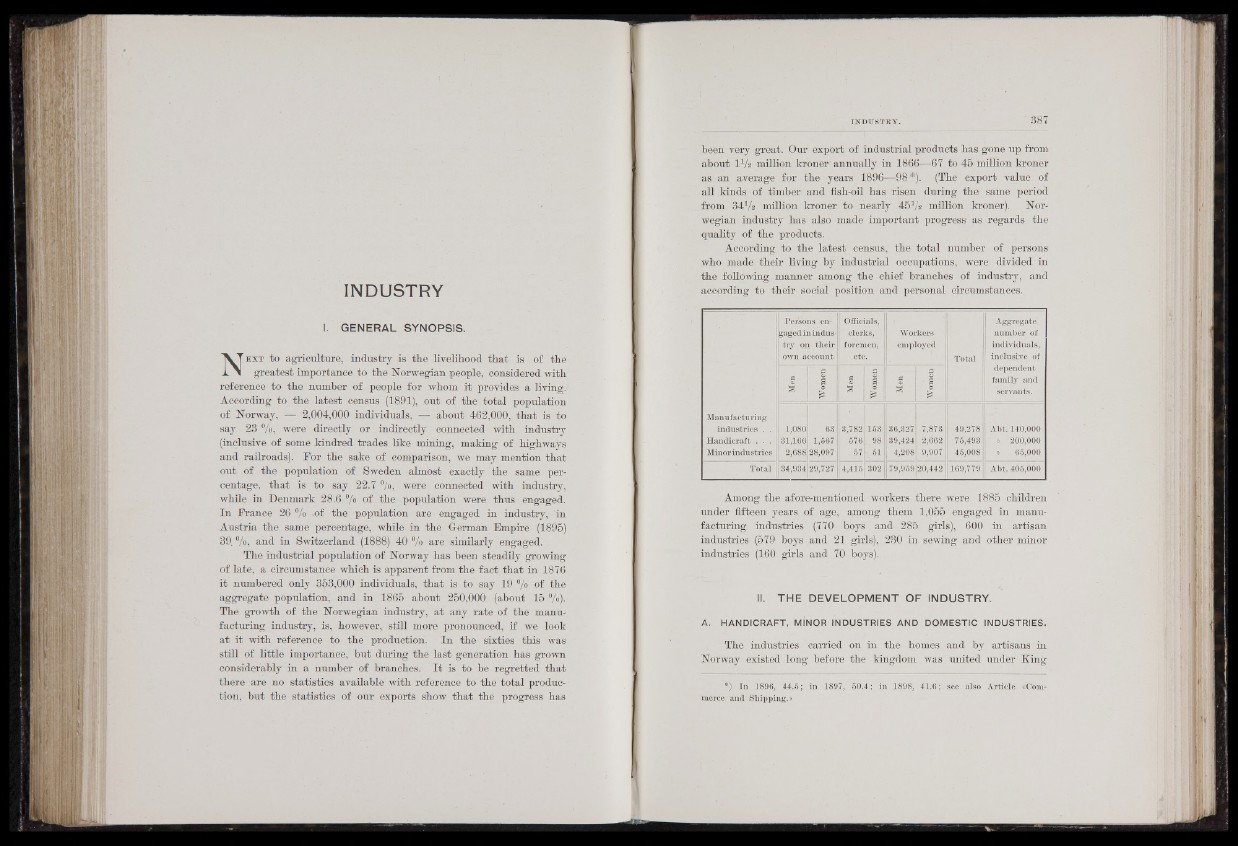
INDUSTRY
I. GENERAL SYNOPSIS.
Ne x t to agriculture, industry is the livelihood that is of the
greatest importance to the Norwegian people, considered with
reference to the number of people for whom it provides a living.
According to the latest census (1891), out of the total population
of Norway,!^ 2,004,000 individuals, B Ja b o u t 462,000, that is to
say 23 %, were directly or indirectly connected with industry
(inclusive of some Mndred trades like mining, making of highways
and railroads). For the sake of comparison, we may mention that
out of the population of Sweden almost exactly the same percentage,
that is to say 22.7 °/o, were connected with industry,
while in Denmark 28.6 % of the population were thus engaged.
In France 26 % -of the population are engaged in industry, in
Austria the same percentage, while in the German Empire (1895)
39.%, and in Switzerland (1888) 40 % are similarly engaged.
The industrial population of Norway has been steadily growing
of late, a circumstance which is apparent from the fact that in 1876
it numbered only 353,000 individuals, that is to say 19 % of the
aggregate population, and in 1865 about 250,000 (about 15 %).
The growth of the Norwegian industry, at any rate of the manufacturing
industry, is, however, still more pronounced, if we look
at it with reference to the production. In the sixties this was
still of little importance, but during the last generation has grown
considerably in a number of branches. I t is to be regretted that
there are no statistics available with reference to the total production,
but the statistics of our exports show that the progress has
been very great. Our export of industrial products has gone up from
about 1 7a million kroner annually in 1866—67 to 45 million kroner
as an average for the years 1896—98 *). (The export value of
all kinds of timber and fish-oil has risen during the same period
from 347s million kroner to nearly 457? million kroner)-: Norwegian
industry has also made important progress as regards the
quality of the products.
According to the latest census, the total number of persons
who made, their living by industrial occupations, were divided in
the following manner among the chief branches of industry, and
according to their social position and personal circumstances.
Persons engaged
in industry
on their
own account
Officials,
clerks,
foremen,
etc.
Workers
employed
Total
1 Aggregate
number of
individuals,
inclusive of
dependent
family and
servants.
. 3
3
Women j
Men.-.
§ .
£
MMÜ <o '
s 1
Manufacturing
industries 1,080 63 3,782 163 36,327 7,873 49,278 Abt. 140,000
Handicraft . . . 31,166 1,667 676 , 98 39,424 2,662 75,493 » 200,000
Minor industries 2,688 28,097 .67 7 51 4,208 9,907 45,008 » 65,000
Total 34,934 29,727 4,416 302 79,959 20,442 169,779 Abt. 405,000
Among the afore-mentioned workers there were 1885 children
under fifteen years of age, among them 1,055 engaged in manufacturing
industries (770 boys and 285 girls), 600 in artisan
industries (579 boys and 21 girls), 230 in sewing and other minor
industries (160 girls and 70 boys).
II. THE DEVELOPMENT OF INDUSTRY.
A. HANDICRAFT, MINOR INDUSTRIES AND DOMESTIC INDUSTRIES.
The industries carried on in the homes and by artisans in
Norway existed long before the kingdom was united under King
*) In 1896, 41.5; in 1897, 60.4; in 1898, 41.6; see also Article «Com-
merce and Shipping.»